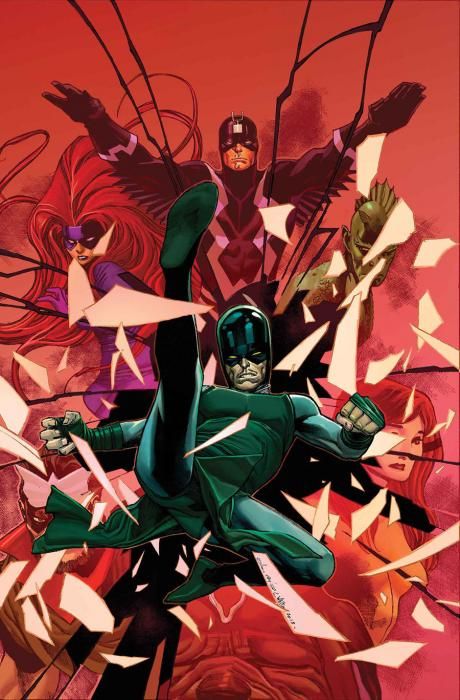As the Marvel universe gears up for the world-changing effects of Black Bolt's Terrigen Mist bomb, Matt Fraction and Olivier Coipel's "Inhumanity" #1 explores the evolution that brought the Inhuman race to its radical expansion. The issue, which seeks to familiarize the Inhuman royal family and its people with a new audience, is extremely effective at what it does; the story unfolds in a natural but compelling way through Karnak's narration and gets carried smoothly by some strong if standard artwork. Clocking in at forty pages, this one-shot book can be a little dense if only for the sheer amount of exposition that's included, but Fraction and Coipel manage to jam in a lot of information into the story in an engaging, easy-to-read way.
Fraction makes a brilliant choice in using Karnak as the narrator. With his superhuman ability to see weakness, Karnak simply makes the most sense. Not only does that decision provide an inhuman perspective on history, it likewise gives voice to a character that would be able to see the overarching implications of the Terrigen Mist bomb's detonation while giving the most accurate overview of the Inhumans' origin. Where Gorgon or Medusa may have had a more skewed perspective on the Inhumans' role in history, Karnak lays out his thinking in a way that gives the reader a more complete picture as he locates the faults in the system.
What's more, Fraction uses Karnak to fill the Avengers in on important information, simultaneously providing a reasonable platform for Karnak to speak on the subject. Additionally, his tone and narration set up a great contrast for the shocking last moments of the issue. Karnak's panic genuinely reflects the seriousness of the danger already in motion and effectively sets the stage for upcoming arcs. With the ending executed this way, the book's conclusion organically transfers the narration from Karnak and Medusa in one fell swoop, just in time for the next installment.
Although Fraction's narrative choices are solid, using Karnak has its drawbacks. For instance, Karanak relates a scene about Medusa that took place just after Attilan's fall that he was neither present for nor had any way of knowing about, at least as indicated in the narration or the art. Due to the sheer amount of background Karnak needs to impart, the issue does drag a little in the middle, especially since the story is bookended by action scenes; however, this may be more to blame on the fact that all of this information needed to be crammed into a singular if extended issue.
Coipel -- the book's main artist -- and inker Mark Morales offer up some industry standard art this issue with a style both clean and easy to follow. Their familiarity with the characters shines through in the figures' posturing, which reflects everything from Hawkeye's nonchalant attitude to Karnak's rigid formality to Medusa's regality. They also carefully include little, fascinating details in the background of select panels, such as Karnak's constant recreation of Black Bolt's symbol. Although Lenil Yu, Gerry Alanguilan, Dustin Weaver and Israel Silva's work appear as guest art through flashbacks in the issue, their style doesn't deviate much from Coipel's established work. Between the six of them, the book has a cohesive flow; it's hardly noticeable that there's a changeup in artist at all. Laura Martin adds a further cohesiveness to the comic through her bright colors, propelling the story along with vivid backgrounds.
"Inhumanity" #1 opens like a fairy tale and closes with a killer reminder of reality. With Matt Fraction and Olivier Coipel at the helm, the book lays a solid foundation for events to come as the Marvel universe braces itself for change. "Inhumanity" is an excellent and engaging introduction to the Inhumans that is sure to please new and old readers alike. I know I'm hooked.

